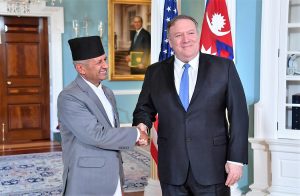Stuck between two emerging powers, China and India, Nepal finds itself in a tight spot geopolitically. The existing powers perceive the Himalayan country as having a difficult choice to make between China’s Belt and Road Initiative (BRI) and the United States’ Indo-Pacific Strategy. Although Nepal already made a statement by signing a BRI agreement with China on May 12, 2017, the controversy surrounding U.S. engagement in Nepal persists. The issue here is that the great powers continue to make moves based on hackneyed interpretations of the Himalayan nation’s interests.
Since the signing of BRI, Nepal and China’s relationship has only grown stronger, while its southern neighbor India is trying to mend its 2015 mistakes — such as the imposition of an economic blockade after Delhi disapproved of Nepal’s promulgated constitution. Why does India’s relationship with Nepal matter for the success or failure of the Indo-Pacific Strategy? This is simply because the United States has handed the baton of overseeing the South Asian region to India for a long period of time now – and to make this clearer U.S. President Donald J. Trump approved this in his recent India visit. This move to use India to manage other South Asian countries, however, hasn’t gone well for the struggling superpower.
In a recent article, Alyssa Ayres of the Council of Foreign Relations says that “The Indo-Pacific framework inherently places India at the heart.” On the other hand, the U.S. Embassy in Nepal and the incumbent U.S. ambassador to Nepal have continuously put forward the rhetoric that the United States doesn’t see Nepal from the eyes of India. American officials in Washington D.C. and those visiting Nepal have given a completely different version of this, stating that the Indo-Pacific is the United States’ strategy to deal with Nepal. These divergent statements not only confuse policymakers and critics within Nepal, but also pit the Indian administration against the United States. Unlike Ayres, who argues for trusting India more, I argue that the United States needs to deal with Nepal on a face-to-face basis if it desires to keep China at bay. However, with the emergence of the BRI and Nepal’s tilt toward China, this is unlikely.
Nepal is a young federal democracy and although its government is now stable, it is a communist one. The United States has a slight advantage over China to reap fruit from it, simply because Nepal still adheres to a democratic state structure. This was evident in the recent call by the Indian prime minister, Narendra Modi, to reignite the slumbering South Asian Association for Regional Cooperation (SAARC) on March 25. At that meeting, Modi proposed a $10 million fund and a number of other initiatives to combat the coronavirus pandemic. Nepali Prime Minister K.P. Oli, meanwhile, pledged $1 million on March 20 during his live telecast address to the nation. This sudden cooperation is lauded by many, with the hope that perhaps SAARC will come to life again.
Meanwhile, with China bringing the coronavirus outbreak under control, it has now reached out to Nepal, India, and other as many as 10 other Eurasian and South Asian countries as of March 20 to help out these nations in their respective fight against the virus. Nepal has already provided a list of items it needs to China on their request. Jack Ma, the founder of Alibaba Group, also tweeted on March 21 that they are providing 1.8 million masks, 210,000 test kits, 36,000 protective suits, plus ventilators and thermometers to Nepal, Afghanistan, Cambodia, Laos, Mongolia, Myanmar, Pakistan, and Sri Lanka. All these developments only suggest that China is in no mood to lose to the United States.
But the United States was ahead of both India and China in helping out Nepal. The United States Agency for International Development (USAID) provided personal protective equipment (PPE) to the Nepal government on March 6 and also assisted the Nepal Army on February 18, with seven sets of medical personal protection equipment, 400 sets of latex gloves, and 110 biohazard bags to evacuate Nepali students from Wuhan city, the epicenter of the coronavirus outbreak. The United States also pledged $1.8 million in assistance to Nepal on March 19 for its fight against the virus. In this sense, the geopolitical picture is clear.
Despite the United States playing a key role in assisting Nepal’s democratic institutions to flourish through various assistance programs, geopolitics and geopolitical distance come to make a difference. Like in the past, the U.S. administration continues to tackle Nepal through the lens of India – which, in itself, is problematic to Nepali policymakers, analysts, and even the Nepali people. The outcome of the coronavirus outbreak and the help of India, China, and the United States toward Nepal will manifest in its future and in how the country responds to the geopolitical competition as the global economy is hit and a landlocked nation like Nepal largely depends on India and China. A temporarily closed border on the south will, of course, prove an advantage to China, and a disappointment for India.

































